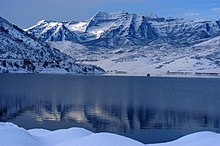Provo Canyon
[3] Provo Canyon has served as a route of transportation between the valleys to the east and west of the Wasatch mountain range.
[4] Soon after permanently settling in the Salt Lake Valley, President Brigham Young of The Church of Jesus Christ of Latter-Day Saints began to send colonizing parties throughout the nearby regions.
[1] The Timpanogos Utes resided in both Utah Valley and the Uinta Basin; therefore, Provo Canyon provided an essential connection so that these Native Americans could communicate and interact more effectively amongst themselves.
[7] The plant was quickly purchased from Telluride by the Utah Power and Light Company and the station remained in operation until 1940.
This "New Deal" consisted of a set of political-economic institutions that were established with the purpose of regulating the United States economy during the Great Depression.
The Public Works Administration was a New Deal institution that was created to combat the lack of civil construction in the Great Depression economy.
[9] After the Public Works Administration was established in June 1933, residents in the Utah Valley region began to request that a dam and reservoir be constructed on the Provo River in order to create jobs and facilitate agriculture.
[10] Deer Creek Reservoir was constructed southwest of Heber City, Utah on the Wasatch side of Provo Canyon.
[3] The main water supply for Deer Creek Reservoir is the Provo River, whose headwaters lie in the Uinta Mountains.
After a years long battle with Lucien L. Nunn over right-of-way issues in the canyon, construction of the railroad was completed in 1899.
When US-189 was paved in the early 1930s, passenger and cargo traffic on the Heber Creeper significantly decreased because people and goods started using automobiles rather than railroads.
Sundance is widely known for its skiing, but the resort also offers activities during the summer, including mountain biking, hiking, and scenic lift rides.
Nunn a pioneer of hydroelectric power, he used the flows of the Provo River to create the first 44,000-volt hydropower powerplant in America.
The plant provided power for mining operations in the canyon, but the grounds would eventually be sold to Utah County as a park site.
In previous years visitors would take the Bridal Veil Falls to a restaurant on the mountain, however, due to avalanche damage the tram was closed in 1996.
[22] Provo Canyon has a long history of avalanches that have blocked travel, caused hundreds of thousands of dollars in damage, and killed both residents and workers.
One of the earliest avalanches in the canyon on record occurred on February 18, 1897 and killed William (Bill) Ferguson, founder of Vivian Park, in his home in South Fork.
[23] One of the main slide paths in Provo Canyon is located directly above the famous Bridal Veil Falls, and numerous avalanches over the years have caused dramatic damage to the area.
Avalanches in the early and mid 1900s blocked travel and would close Provo Canyon for days, and sometimes weeks, on end.





